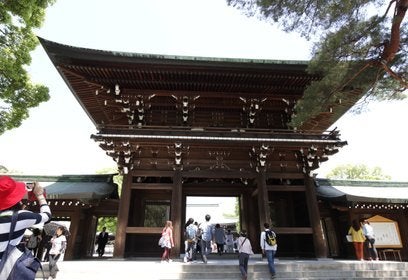本殿へ
こんにちは。
美沙です。
本日は、日本の事物、習慣など
を説明してみましょう。
今回の記事を読んでいただければ
日本の物、習慣など
どんな風に分かりやすく
説明できるんだろう?
しどろもどろにならない
かしら?
なんていう心配をしなくて
よくなります。
ですので、1分だけ私に
あなたのお時間をください。
「後に読もう。」「読む時間がない。」と
あなたが今この記事を読まなければ
この先も
「英語で日本事情を説明するのは
苦手、苦痛」な状態は変わることなく
1週間後、1年後も今の状態は
変わることなく益々嫌いになって
いく一方でしょう。
たった1分だけでいいですので
これから書く記事を読み進めて
いただければと思います。
それでは書いていきますね。
それでは日本の事情、習慣などを
分かりやすく出来る様になるために
今回の記事の内容を最も効率的に
体感して頂く為の
具体的なステップを書いていきます。
【 ステップ1】
声に出して読む。
【 ステップ2】
赤い文字の単語、フレーズを
ノートに書き出し覚える。
毎日少しずつでも覚えていくと
フレーズの引き出しが
一杯になって、会話が楽しくなります。
【ステップ3】
普段から身の回りにある
物、日本独特な感じ方、習慣等を
なんて説明できるかしら?と考える
習慣をつけると急速にあなたの
英語は豊かな物になっていくでしょう。
ネットを大いに活用しよう!
本殿に行きます
M: Are you interested in precincts(通例 複数で)
of the Shrine? Shall we go before lunch?
☆ be interested in~:~に名詞(動名詞)を入れて
「~に興味がある、~したい」
A: It’s nice.
M: This way.
The shrine was built to enshrine (祀る)
the Empress Meiji Kyoken in 1893.
A: How gentle he was ! I want someone who
present me such a beautiful garden.
What a big magnificent wood gate !
M: Please watch your step.「足元に気をつけて。」
二人は境内に入ります。
A: Are they who wear white clothes priests?
M: Yes they are young Shinto priests.
under training. They sweep precincts,
sell fortune slips(おみくじ)etc.
☆ Omikuji is a piece of paper
whch can be got in the most Shinto shrines.
You can pick it up at random
and on the paper,it is saying how lucky you are.
You might see in shrines many paper fortune
is fastened to trees or ropes.
There are some explanations for this costum
and major one is like this.
"If the paper says you'll have excellent luck
this year,you should bring it on your person.
However,if it says bad luck might strike you this year
you can fasten up to a tree or a rope in the shrine
and you can escape from the bad lluck.
When we come here ,we throw some coins
in the offering box (賽銭箱)to pray for
the Diety ,Kami, or Holy Ghost.
We pull this rope to ring the bell to thank
Kami-sama for listening our wishes.
A: I see ,I’ll make my wishes .
二人は手を合わせしばらくそれぞれのお願い事を
しました。
M: Some young couples get married
in Shinto style ,in Christian way
and Buddhist way.
In Japan, there are many styles
to celebrate marriages.
We are generous in all the religions.
☆ be generous :=「寛大な」
A:That 's what I like Japanese people.
M :There are many events all through
the year.
In November, there is
"shiti-go-san"=「七五三」
( The festival day for children
aged seven,five,three)
They are celebrated by their parents,
relatives and friends for their good growth
without sicknesses.
And they ask the Gods for their happinesses
and good health for all their lives all through
their lives.
☆ ask for ~:~に名詞、動名詞を入れて
「~をお願いする。頼む」
Some students who wish to pass their examinations
come here to ask Kami-sama, anytime.
Some people who wish
recovery of sickness of relatives
parents, friends come to the Shrine.
Anyone can come here to pray for their wishes, anytime,
like your church.
And when a baby is born, family members
bring the baby to the Shrine.「お宮参り」
to ask Kami-sama for his/her health and
happiness like your church,
On 31st of December, New Year’s Eve,
many folks gather to wait to celebrate
the 1st day of the New year together
listening to the toll of temple bell on the new Year.
「除夜の鐘」
It’s said during the first week of January,
paying your first visit too the Shrine (初詣)
brings you good luck ,health and happiness.
A: Such a sacred ,holy place is necessary
in our daily lives.
M: I think so too.
目の前に実物が あるんです。
"Seeing is believeng"(百聞は一見にしかず)
ということわざ(saying/proverb) があるように
目に入る物 から説明して
いけばよいので
決して難しくないですよね。
二人は境内を後にします。
いよいよランチタイムです。
それでは最後に今日の記事を
読んで頂きまして少しでも
お役に立てましたなら今すぐ
『いいね』」ボタンを押してください。
それではこの辺で。
最後までお読みいただきまひて
ありがとうございます。
明日も楽しみにしていてください。
